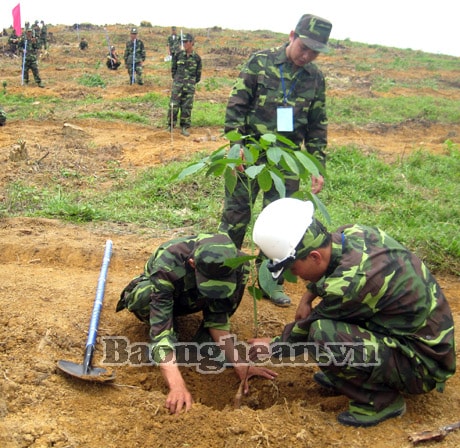Responding to climate change efforts
(Baonghean) - Climate change, first of all global warming and rising sea levels, is one of the biggest challenges facing humanity in the 21st century. According to forecasts, Vietnam is one of the countries severely affected by climate change. Nghe An is the same, from now on, each person with their small actions can also contribute to combating climate change.
(Baonghean) - Climate change, first of all global warming and rising sea levels, is one of the biggest challenges facing humanity in the 21st century. According to forecasts, Vietnam is one of the countries severely affected by climate change. Nghe An is the same, from now on, each person with their small actions can also contribute to combating climate change.
Statistics from the North Central Hydrometeorological Center show that in recent years, Nghe An has shown signs of climate change: Average temperatures have tended to increase, rainfall in many areas has decreased significantly, droughts have become more severe, storms and floods have become more severe, saltwater has encroached deeper into rivers and there has been erosion of banks in some coastal areas, land in many areas has become increasingly dry, biodiversity has decreased sharply, many new diseases have appeared...
Rainfall in Nghe An in the last 3 decades of the 20th century has a general tendency to decrease. In recent years, the number of severe cold spells and frosts has tended to increase. In 2005 and 2007, the total number of severe cold spells and frosts reached 7 and 6, respectively. Meanwhile, the number of storms landing in Nghe An has a tendency to decrease. In 2009: There were 6 tornadoes, hail, lightning strikes and heavy rain and floods in September 2009, killing 25 people, injuring 53 people, causing damage of 444 billion VND. In 2010, Nghe An had 9 tornadoes, hail, flash floods and 1 storm No. 3, with 2 floods from 1 to 5/10 and from 14 to 20/10, causing great damage. Of which, storm No. 3 had winds of level 10, 11, gusting to level 12, causing heavy rain. The flood from October 14 to 20 inundated the delta for many days.
The agriculture, forestry and fishery sectors are forecast to be greatly affected by climate change due to natural disasters and disease outbreaks. To combat climate change, in recent years, many localities in the province have promoted afforestation projects such as the Kfw4 Project, the Vietnam-Germany Forestry Project, the Wb 3 Project, and the Forestry Development Project. Thanks to that, Nghe An's forest coverage is the highest in the country (over 53%).
Implementing the rubber tree planting project in Thanh Duc commune (Thanh Chuong).
In addition, activities of protecting and regenerating forests, reclaiming and restoring degraded land and mountainous land in Do Luong, Tan Ky, Anh Son districts, planting mangrove forests to prevent waves in Dien Kim, Dien Van (Dien Chau), Nghi Thiet (Nghi Loc). Farmers in the districts have introduced new applications in production, livestock, new plant and animal varieties to adapt to climate change, green production movements such as: Tan Ky produces microbiological fertilizers at households; growing clean tea in Anh Son; growing safe vegetables in Vinh city, Quynh Luu. Many environmental protection projects such as: growing safe vegetables according to VietGAP in Quynh Minh, raising safe biological pigs in hamlet 4 (Quynh Doi); integrated pest management application model (IPM), 3 reductions 3 increases (ICM), improved rice intensification, model of using green fungus Metarhizium in preventing rice planthoppers, have been implemented in many communes in the province.
In recent years, many irrigation works have been invested in repairing, restoring, upgrading and renewing such as the Northern irrigation system, the Southern irrigation system, Ke Coc, Khe Nha, Song Sao Lake, Kem Ai, Pha Lai projects, Thanh Chuong, Do Luong, Anh Son, Yen Thanh dams... The whole province has solidified more than 4,420 km of canals, bringing the total irrigation area to 225,000 hectares, of which the stable irrigation area is 175,000 hectares. The work of repairing dykes and preventing floods and storms has also received significant investment. However, the investment level in recent years for repairing irrigation systems and dykes is still low compared to the requirements, many places have seriously degraded...
Although we have tried very hard, it is like "a drop in the ocean", because industrialization is developing strongly in the world, leading to many big cities being stuffy and lacking trees and air. Every citizen can participate in fighting climate change. Turn off an unnecessary light, do not turn on the air conditioner too cold, reduce the use of plastic bags, use food and food reasonably, avoid waste, plant one more tree every year, have a positive attitude towards acts that pollute the environment, save clean water, save gasoline, oil, protect forests... all are actions to prevent the temperature from warming too quickly, so that natural resources are not exhausted.
In Vinh City, we met many women carrying baskets to the market to avoid using plastic bags, and saw many people participating in planting trees in their homes, and voluntarily cleaning up their neighborhoods on weekends... In Do Luong and Thanh Chuong, there is a movement to clean up pesticide packaging in the fields, and in Cua Lo Town, people have invented a sand sieve to pick up trash on the beach...
Nghe An has also developed a provincial action plan to respond to climate change for the period 2011-2015 (up to 2020) in conjunction with the national climate change response plan. The goal is to assess the impact of climate change on natural conditions and natural resources, socio-economic development, people's lives and livelihoods based on climate change scenarios published by the Ministry of Natural Resources and Environment.
However, without promoting propaganda and raising awareness in the community, without the participation of all levels, sectors and the entire population, the desired results will not be achieved.
Chau Lan






